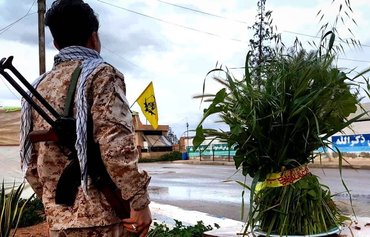Despite its attempts to deflect blame onto other parties, Iran's Islamic Revolutionary Guard Corps (IRGC) bears direct responsibility for the recent drone attack on al-Tanf air base in southern Syria, analysts said.
On August 15, US forces shot down two drones targeting al-Tanf base in the tri-border area along the Syrian, Jordanian and Iraqi frontiers. The attack did not result in any injuries or damage.
Later findings indicated that the unmanned aerial vehicles (UAVs), identified as Iranian Samad series drones, had been launched from the Jurf al-Sakhr complex, in Babil province, south of Baghdad.
The complex is a fully closed "military zone" controlled by Kataib Hizbullah, the IRGC's main Iraqi affiliate.
![Children in al-Rukban camp, near al-Tanf base, greet a US soldier on August 18. [US Army Commandos/Facebook]](/cnmi_am/images/2022/09/07/36962-al-tanf-3-600_384.jpg)
Children in al-Rukban camp, near al-Tanf base, greet a US soldier on August 18. [US Army Commandos/Facebook]
"The attack that targeted al-Tanf base was an explicit Iranian attack on a US military base," said Iranian affairs researcher Fathi al-Sayed of the Middle East Centre for Regional and Strategic Studies.
"It's an indication that the IRGC intends to continue to cause tension in the Middle East to serve its purposes and plans," he said.
The IRGC and Kataib Hizbullah attempted to obfuscate their role by blaming the Syrian opposition for the assault, he said, remarking that this "is a tactic we have seen before from the IRGC".
"These evasions have been used previously in Lebanon, Iraq and Yemen, in attempts to duck responsibility for the [political or military] consequences of the terrorist acts they carry out," he said.
The deflection of blame also feeds the media narrative that the attack was "an act of resistance by the Syrian people" to the West and its allies, he added.
"This is totally inaccurate, especially given the tremendous role, effort and sacrifices made by the US forces and their local allies in confronting the 'Islamic State of Iraq and Syria' (ISIS), and ridding the Syrian people of it," he said.
High probability of future attacks
The responsibility for the attack on al-Tanf base lies "directly and solely" with the IRGC, said Iranian affairs researcher Sheyar Turko, who specialises in the financing and deployment of the IRGC and its allied militias.
This is the case "even if affiliated groups carried out the attack from Iraqi territory", he said, "as the drones are Iranian made and have been distributed to all its affiliates in Lebanon, Syria, Iraq and Yemen".
"The final and ultimate decision to use them it is made in Tehran by the IRGC's leadership itself," he said.
Turko said there is a high probability that attacks of this nature will continue, possibly carried out by IRGC affiliates other than Kataib Hizbullah.
He pointed to recent confirmed reports that UAVs "were transferred to Syria and delivered to the Fatemiyoun Division".
In Syria's eastern desert (Badiya), members of the Fatemiyoun Division, which is comprised of Afghan fighters, received training on how to launch the drones from by Iranian specialists and trainers affiliated with Lebanese Hizbullah, he said.
Turko noted that Hizbullah itself possesses "a fleet of these drones", and it cannot be ruled out "that it would use them in Syria at any time".
Ignite the region
Al-Tanf base houses US forces operating as part of the international coalition and members of Jaish Maghawir al-Thawra, an anti-extremist Syrian opposition militia, said Jaish Maghawir al-Thawra element Nassif al-Khalidi.
By targeting al-Tanf, he said, it appears that "the IRGC wants to ignite this region and weaken it militarily, or divert attention and operations away from ISIS and direct them toward operations carried out by Kataib Hizbullah".
Al-Khalidi noted that the so-called 55km area, which encompasses al-Rukban camp and al-Tanf base, is "a very safe area and one of the few areas in Syria that have been totally purged of ISIS".
"The mission of protecting civilians is top priority for both the US forces and Jaish Maghawir al-Thawra," he said.
The drones pose "a threat to civilians in the camp", he said.
"If one misses its target and falls in the camp, there would be many civilian casualties, because the camp's houses are modest and the camp itself is not equipped with emergency shelters."

![Remnants of one of the two drones that were shot down in August before they hit al-Tanf base in southern Syria are seen here. [Jaish al-Maghawir/ Facebook]](/cnmi_am/images/2022/09/07/36960-al-tanf-1-600_384.jpg)






